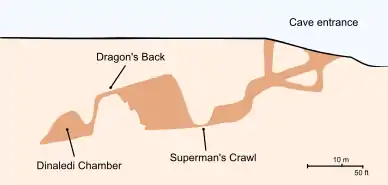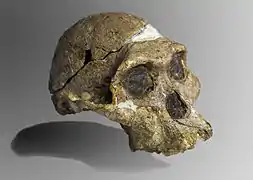Underground Astronauts
The Underground Astronauts is the name given to a group of six scientists[1] who excavated the bones of Homo naledi from the Dinaledi Chamber in South Africa.[2][3] Hannah Morris, Marina Elliott, Becca Peixotto, Alia Gurtov, K. Lindsay (then Eaves) Hunter,[4] and Elen Feuerriegel were selected by expedition leader Lee Rogers Berger.[5][6]

In November 2013, the National Geographic Society and the University of the Witwatersrand funded an expedition called Rising Star Expedition for a twenty-one day excavation at the cave,[7] followed by a second expedition in March 2014 for a 4-week excavation in the Dinaledi Chamber. In total, the expedition retrieved 1,550 pieces of bone belonging to at least fifteen individuals, found within 1 m2 of clay-rich sediments.[8] They entered a narrow opening in the cave to reach the chamber where the bones were located,[9] and as the expedition was dangerous, they were named the Underground Astronauts.[10]
Excavator team
- Hannah Morris, archaeologist.
- Alia Gurtov is a University of Wisconsin – Madison Ph.D. candidate researching the effects of seasonality on hominin foraging at Olduvai Gorge, Tanzania.
- Marina Elliott is originally from Calgary, Canada, and has a master's degree in biological anthropology from Simon Fraser University, Canada.
- Elen Feuerriegel, then a PhD candidate at the Australian National University, studying shoulder biomechanics with Colin Groves in Oldowan stone tool manufacture.
- Becca Peixotto is an archaeologist and Ph.D. student in the Department of Anthropology at American University in Washington, D.C.[11]
- K. Lindsay (Eaves) Hunter is a biological anthropologist and current archaeology PhD student at the University of the Witwatersrand PhD, as well as the Project Manager/Facilitator for the National Geographic "Umsuka" Public Palaeoanthropology Project based in Johannesburg, Gauteng Province, South Africa. The Nat Geo "Umsuka" project has a focus on promoting education, inclusivity, and accessibility regarding the Cradle of Humankind. Following the 2013 expedition, Lindsay married Rick Hunter, one of the co-discoverers of Homo naledi.[11][4]
References
- "These 6 women risked death for an amazing scientific discovery". Tech Insider. Retrieved 2016-01-07.
- "Meet the "underground astronauts"". CNN. 2015-09-10. Retrieved 2016-01-05.
- Bennett, Amanda; Geographic, National (2015-09-17). "Wanted: Fit, Fearless Scientist for Huge Underground Find". National Geographic News. Retrieved 2016-01-05.
- Hunter, K. Lindsay (1 Sep 2017). "K. Lindsay Hunter". LinkedIn. Retrieved 1 Sep 2017.
- Feltman, Rachel (September 10, 2015). "Meet the six female 'underground astronauts' who recovered our newest relative". The Washington Post. Retrieved 10 January 2016.
- Smith, David (10 September 2015). "'Small spelunkers required': the ad that led to the discovery of Homo naledi". The Guardian. Retrieved 10 January 2016.
- Bascomb, Bobby (10 September 2015). "Archaeology's Disputed Genius". PBS. Retrieved 22 September 2015.
- Howley, Andrew (6 November 2013). "Rising Star Expedition: Prehistory in the Making". National Geographic Society. Archived from the original on 9 September 2015. Retrieved 8 September 2015.
- McKenzie, David; Wende, Hamilton (2015-09-10). "Homo naledi: New species of human ancestor discovered". CNN. Retrieved 2016-01-05.
- eNCA (2015-09-14). "'Underground astronaut' shares Homo naledi experience". eNCA. Retrieved 2016-01-05.
- "Who are the Underground Astronauts?". EWN. Retrieved 2016-01-05.
| Wikimedia Commons has media related to Underground Astronauts. |
